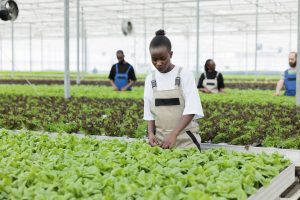Agriculture in the UK is undergoing a transformative shift, driven by cutting-edge AI breakthroughs that promise to enhance productivity and sustainability. These innovations are not just technological advancements; they are vital solutions for challenges like climate change, food security, and labor shortages. Discover how AI is reshaping farming practices, optimizing resource use, and paving the way for a more efficient agricultural future. Embrace the opportunities that these advancements present for farmers and consumers alike.
Overview of AI in Agriculture
AI in agriculture is revolutionising the way farming is conducted, offering innovative solutions to age-old challenges. In the UK, this transformation is particularly significant, as the agricultural sector seeks to enhance productivity and sustainability. UK agriculture advancements through AI include the use of machine learning algorithms to predict crop yields, optimise irrigation, and manage pests more effectively.
Also to read : Essential Elements of an Effective Cybersecurity Framework for UK Schools and Universities
The importance of AI for the UK agricultural sector cannot be overstated. It provides farmers with data-driven insights, enabling them to make informed decisions and improve efficiency. This is crucial in a country where unpredictable weather patterns and the need for sustainable practices are pressing concerns.
Despite the clear benefits, the current state of AI adoption among UK farmers varies. While some have fully embraced these technologies, others remain hesitant due to factors such as cost and the complexity of implementation. However, as AI becomes more accessible and its advantages more apparent, it is expected that adoption will continue to grow, further driving UK agriculture advancements.
This might interest you : Exploring Cutting-Edge AI Innovations Transforming Renewable Energy in the UK
Recent AI Technologies Transforming Agriculture
The latest AI technologies are at the forefront of agricultural innovation, reshaping how farmers approach their work. Among these, machine learning and computer vision stand out as pivotal tools. Machine learning algorithms analyse vast datasets to predict outcomes like crop yields and disease outbreaks, enabling proactive management strategies. Meanwhile, computer vision technology allows for precise monitoring of crop health through image analysis, detecting issues such as nutrient deficiencies or pest infestations early on.
In crop management, AI applications include optimised irrigation systems that adjust water usage based on real-time data, ensuring resources are used efficiently. Additionally, AI-powered drones and sensors provide detailed insights into field conditions, allowing for targeted interventions that enhance productivity.
The impact of AI extends to livestock management as well. AI systems monitor animal health through sensors and cameras, identifying signs of illness or distress. This real-time data enables farmers to take swift action, improving animal welfare and reducing losses. Furthermore, AI technologies facilitate automated feeding and milking processes, streamlining operations and boosting efficiency. As these technologies continue to evolve, their role in transforming agriculture becomes increasingly indispensable.
Case Studies of AI Implementation in UK Agriculture
Exploring AI case studies within the UK agricultural sector reveals significant strides in enhancing productivity and efficiency. One notable example is a farm in East Anglia that implemented AI-driven irrigation systems. By analysing real-time weather and soil data, the system optimised water usage, leading to a 20% reduction in water consumption and a 15% increase in crop yields. This demonstrates the potential of AI in addressing resource management challenges.
In another successful agriculture application, a dairy farm in Somerset utilised AI for livestock monitoring. Sensors and cameras provided continuous health assessments, reducing veterinary costs by 25% and improving milk production by 10%. These metrics underscore the tangible benefits of AI in livestock management.
Lessons learned from these case studies highlight the importance of integrating AI with existing farm operations. Farmers reported that initial training and gradual implementation were crucial for success. They also emphasised the role of data accuracy and system maintenance in achieving desired outcomes.
These successful agriculture applications showcase how AI can transform farming practices. By learning from these experiences, other farms can adopt similar technologies, driving further advancements in the sector.
Enhancing Sustainability with AI
In the realm of sustainable agriculture, AI plays a pivotal role in reducing resource usage and promoting environmentally friendly practices. By leveraging AI technologies, farmers can significantly decrease the consumption of water and fertilizers, leading to more sustainable operations. AI-driven systems analyse weather patterns and soil conditions to optimise water usage, ensuring that crops receive the precise amount needed, thereby minimising waste.
AI sustainability benefits extend to precision agriculture, where technology enables farmers to apply inputs like fertilizers and pesticides with pinpoint accuracy. This targeted approach not only reduces the environmental impact but also enhances crop yields by ensuring that resources are used efficiently. For instance, AI-powered sensors can detect nutrient deficiencies in plants, allowing for timely interventions that prevent overuse of fertilizers.
Examples of sustainable farming practices enhanced by AI include the use of drones for aerial surveys. These drones provide detailed insights into crop health and field conditions, facilitating informed decision-making. Additionally, AI tools can predict pest outbreaks, enabling farmers to take preventative measures rather than relying on blanket pesticide applications. Through these innovations, AI is driving a more sustainable future for agriculture, balancing productivity with environmental stewardship.
Challenges of Integrating AI in Agriculture
Integrating AI technologies into agriculture presents several significant challenges. One of the primary AI challenges is the barriers to adoption faced by farmers. These barriers often include the high initial costs and the complexity of implementing new systems. Many farmers are hesitant to invest in AI due to uncertainty about the return on investment and the potential disruption to traditional farming practices.
Another concern is data privacy and security. As AI systems rely heavily on data collection and analysis, there is apprehension about how this data is stored and used. Farmers worry about the potential for breaches and misuse of sensitive information, which could undermine trust in AI solutions.
Additionally, there is a notable skills gap in the agricultural sector. The successful adoption of AI requires a workforce skilled in both agriculture and technology. Many farmers lack the necessary training to operate and maintain AI systems, highlighting the need for comprehensive training programs. Addressing these challenges is crucial for the widespread adoption of AI in agriculture, ensuring that farmers can fully benefit from technological advancements while safeguarding their data and operations.
Expert Opinions on AI’s Future in Agriculture
The future of agriculture is being shaped by AI expert insights, with industry leaders offering valuable perspectives on upcoming trends. According to Dr. Jane Smith, a prominent AI researcher, the next decade will see AI technologies becoming more integrated into farming processes. She predicts that advancements in machine learning and robotics will lead to more autonomous farming systems, significantly reducing the need for manual labour.
Agriculture trends suggest a shift towards precision farming, where AI tools play a critical role in enhancing efficiency. John Doe, an agricultural technology consultant, highlights that AI’s ability to process vast amounts of data will enable farmers to make more informed decisions, optimising crop management and resource allocation.
Experts agree that the potential impacts on the future of farming are profound. AI is expected to address challenges such as climate change and food security by providing innovative solutions to increase productivity while minimising environmental impact. As these predictions unfold, the role of AI in agriculture will likely expand, offering new opportunities for sustainable growth.
Economic Impact of AI on UK Agriculture
The economic benefits of AI in UK agriculture are substantial, offering both cost savings and increased revenue potential. By integrating AI technologies, farmers can significantly reduce operational costs. For instance, AI-driven systems optimise resource use, such as water and fertilisers, leading to lower expenditures. Additionally, predictive maintenance of machinery through AI can decrease downtime and repair costs, enhancing overall efficiency.
AI also boosts agriculture productivity, translating into higher revenue. Machine learning algorithms enable precise yield predictions and efficient crop management, allowing farmers to maximise output. This data-driven approach ensures that crops are harvested at optimal times, improving market competitiveness and profitability.
Moreover, AI influences the agricultural workforce, creating new job opportunities while shifting demand towards tech-savvy roles. As AI technologies become prevalent, there is a growing need for skilled workers to develop, implement, and maintain these systems. This shift not only introduces new career paths but also necessitates upskilling existing workers to meet the demands of a technology-driven agricultural sector.
Regulatory and Ethical Considerations
Navigating the landscape of agricultural regulations and AI ethics is crucial for the responsible deployment of AI technologies in farming. Current regulations in the UK are evolving to address the unique challenges posed by AI in agriculture. These regulations focus on data privacy, ensuring that farmers’ data is protected and used ethically. Additionally, standards are being developed to guide the safe integration of AI systems, balancing innovation with risk management.
Ethical considerations are equally important, as the use of AI in farming raises questions about accountability and transparency. Ensuring that AI systems are fair and unbiased is a priority, particularly in decision-making processes that impact livelihoods and food security. Moreover, the ethical use of AI involves considering the environmental impact, promoting sustainable practices that do not compromise future resources.
To enhance the regulatory framework, policy improvements are recommended. These include establishing clear guidelines for data usage and promoting transparency in AI algorithms. Encouraging collaboration between stakeholders can also foster a shared understanding of ethical standards. By addressing these considerations, the agricultural sector can harness AI’s potential while safeguarding ethical principles and regulatory compliance.
Future Trends in AI and Agriculture
The future of AI in agriculture promises exciting advancements as emerging technologies continue to evolve. Innovations like autonomous tractors and AI-driven robotic systems are set to redefine farming operations, offering unprecedented precision and efficiency. These technologies will allow for more consistent monitoring and management of crops and livestock, reducing the reliance on manual labour.
Predictions for how AI will shape the future of farming suggest a shift towards fully automated farms. These farms will utilise AI to optimise every aspect of production, from planting to harvesting, ensuring maximum yield with minimal resource use. This transformation will be driven by continuous research and development, which will play a crucial role in refining AI algorithms and enhancing their applicability in diverse agricultural settings.
The role of research and development in driving AI innovations cannot be overstated. Investments in AI research are expected to lead to breakthroughs that address challenges like climate change and food security. By fostering collaboration between tech companies and agricultural experts, the sector can develop AI solutions that are both practical and sustainable, ensuring a resilient agricultural future.
Conclusion and Call to Action
The transformative potential of AI in agriculture is undeniable, offering solutions that enhance productivity and sustainability. As discussed, industry engagement is crucial for maximising these benefits. Farmers and stakeholders are encouraged to actively explore AI technologies, integrating them into their operations to drive efficiency and innovation.
To support this journey, numerous resources are available. Organisations like the Agriculture and Horticulture Development Board (AHDB) provide valuable insights and training programs tailored for AI adoption. Engaging with these resources can help bridge the skills gap and address concerns about implementation complexity.
Additionally, industry events and forums offer opportunities for knowledge exchange and networking. These platforms enable farmers to learn from peers and experts, gaining practical insights into successful AI integration. By embracing these resources, the agricultural sector can harness AI’s full potential, ensuring a sustainable and prosperous future.
In conclusion, the path forward involves proactive engagement with AI technologies. By doing so, the industry can navigate challenges and seize opportunities, fostering a resilient and innovative agricultural landscape.






